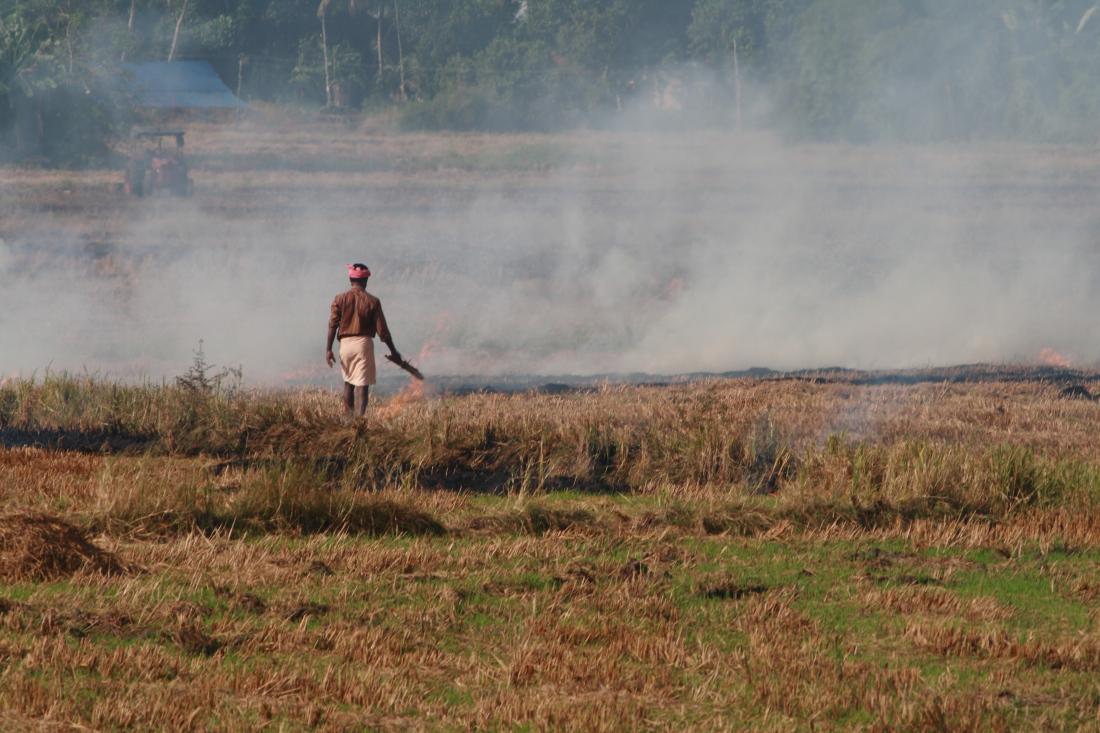The impact of payments for ecosystem services on crop burning in India
- Farmers
- Agro-dealers
- Pollution
- Technology adoption
- Climate change mitigation
- Cash transfers
- Information
- Natural resource management
- Conditional cash transfers
Mechanized rice paddy harvesting has led to widespread burning of crop residue to clear fields after harvest, creating massive air quality problems across northern India. One policy approach to reduce stubble burning is to provide payments for ecosystem services (PES), where individuals are paid to refrain from environmentally damaging behavior. Researchers are conducting a randomized evaluation to test the impact of a PES program that offers financial rewards to paddy farmers for reducing burning of crop residue (or “stubble”) on stubble burning in Punjab, India.
Policy issue
Transitioning from subsistence agriculture to commercial growing can come at a high cost to the environment. Mechanized rice paddy harvesting has increased farmer profits in India but also led to widespread burning of crop residue (stubble) to clear fields after harvest, creating massive air quality problems across northern India. Addressing stubble burning is a high-priority item on India’s central government’s political agenda. One policy approach to reduce stubble burning is to provide payments for ecosystem services (PES), in which individuals are paid to refrain from environmentally damaging behavior. PES programs provide farmers with flexibility in how they manage their crop residue: for example, farmers can rent crop residue management (CRM) equipment and the PES payment would defray the costs, but farmers can also remove and bale the stubble. While PES has been implemented widely, there is limited evidence on the causal effect of PES programs. Can providing PES to farmers on the condition that they not burn their paddies reduce stubble burning?
Context of the evaluation
In the Indian state of Punjab, 83 percent of land is under agricultural cultivation. Rice and wheat are the two most commonly grown crops in Punjab, which alone grows nearly 30 percent of publicly distributed rice in India.
Punjab banned the burning of stubble in 2013, but many farmers do not follow the order. The time pressure to ready fields for wheat planting and the cost of renting CRM equipment has made burning more common in recent years. Each fall, smoke from field burning in Punjab and Haryana chokes northern India, creating a growing public health emergency.

Details of the intervention
Researchers are conducting a randomized evaluation to test the impact of a PES program that offers financial rewards for reducing stubble burning to paddy farmers on stubble burning in Punjab, India.
Of a sample of 171 villages in the districts of Bathinda and Faridkot, where satellite imagery indicates a high rate of burning in 2018, researchers identified ~1700 farmers with an area of paddy cultivation between 2 and 12 acres who reported growing paddy and wheat in 2018. Villages were randomly assigned to one of the following groups:
- Lower PES (30 villages): Farmers were offered a PES agreement that paid them INR₹800 (US$10.71) per acre for up to ten acres (to a maximum of INR₹8,000 (US$107.11) on the condition that they not burn their paddy fields.
- Higher PES (28 villages): Farmers were offered a PES agreement that paid them INR₹1,600 (US$21.42) per acre for up to ten acres (to a maximum of INR₹16,000 (US$214.22)) on the condition that they not burn their paddy fields.
- Lower PES + 25 percent advance (31 villages): Farmers were offered the lower PES agreement, and if they accepted it, received 25 percent of the amount (INR₹200 (US$2.68) per acre for up to ten acres) upon signing. The remainder was paid upon verification of compliance with the agreement.
- Lower PES + 50 percent advance (31 villages): Farmers were offered the lower PES agreement, and if they accepted it, received 50 percent of the amount (INR₹400 (US$5.33) per acre for up to ten acres) upon signing. The remainder was paid upon verification of compliance with the agreement.
- Comparison (51 villages): Farmers engaged in business as usual, with no PES offer.
The protocol as laid out in the PES contracts required farmers to call the project team once they had managed stubble, but before sowing wheat. A monitor would then visit the farmer to assess the burning status of their plots. Farmers that burned were not required to call the project team at all.
Researchers collected baseline data starting in September 2019, followed by delivery of the PES intervention in October 2019. This was followed by in-person assessment of whether farmers offered PES contracts burned stubble spanning from mid-October to early December 2019. Endline data collection occurred between June and July 2020 and was conducted over the phone as a Covid-19-related precaution. Researchers collected data related to the farmer’s agricultural practices, household members’ recent health, and the impact of COVID-19 on agriculture practices.
Results and policy lessons
Analysis ongoing; results forthcoming.